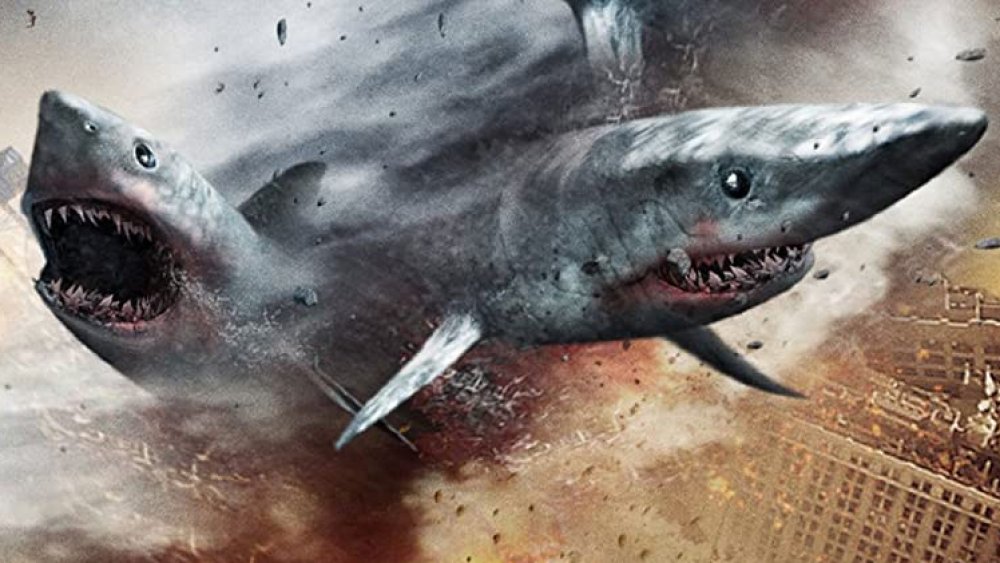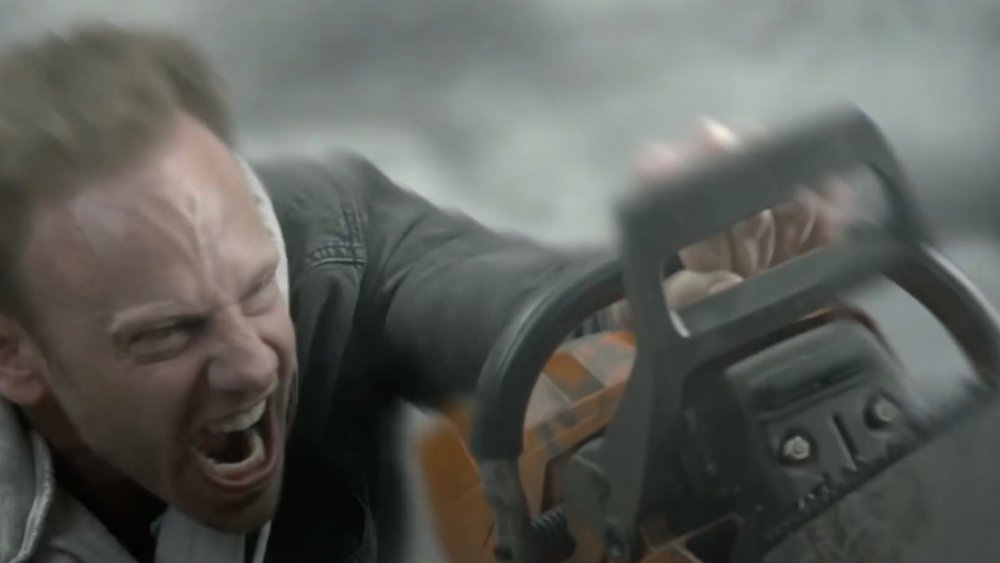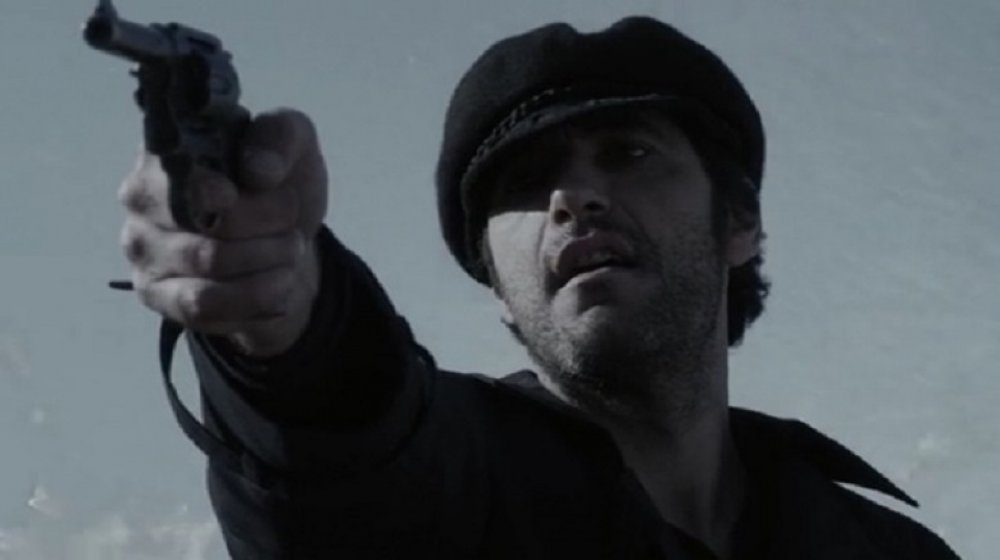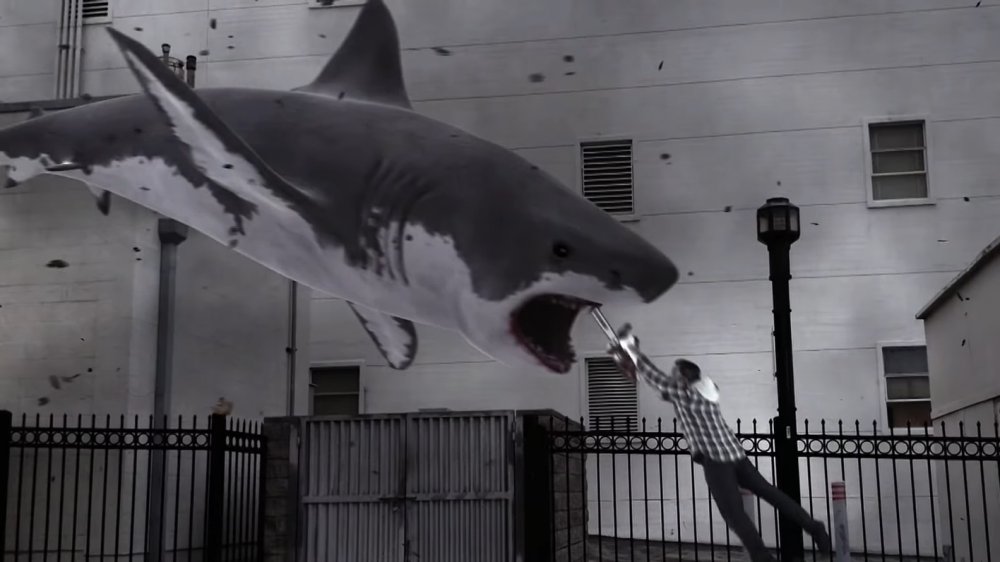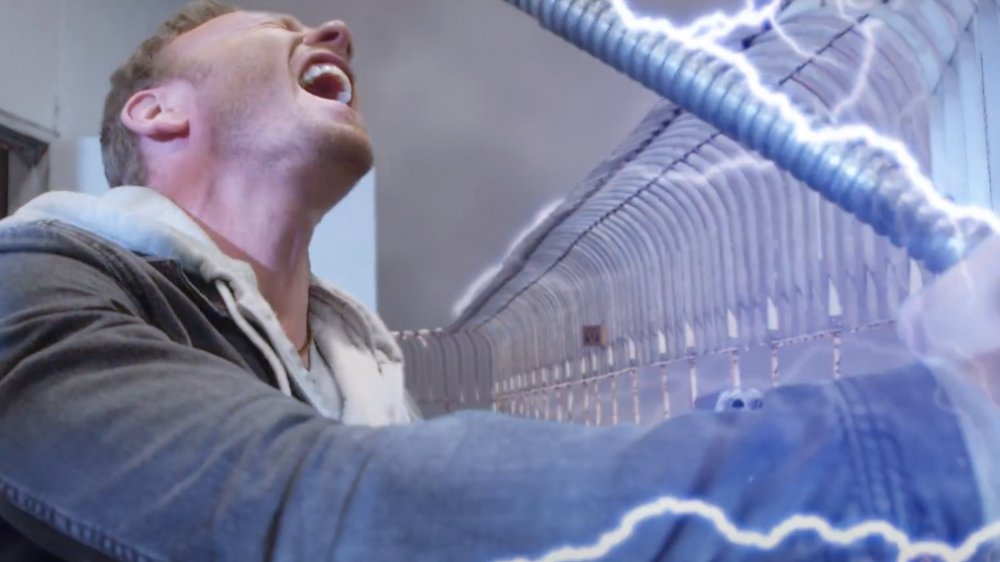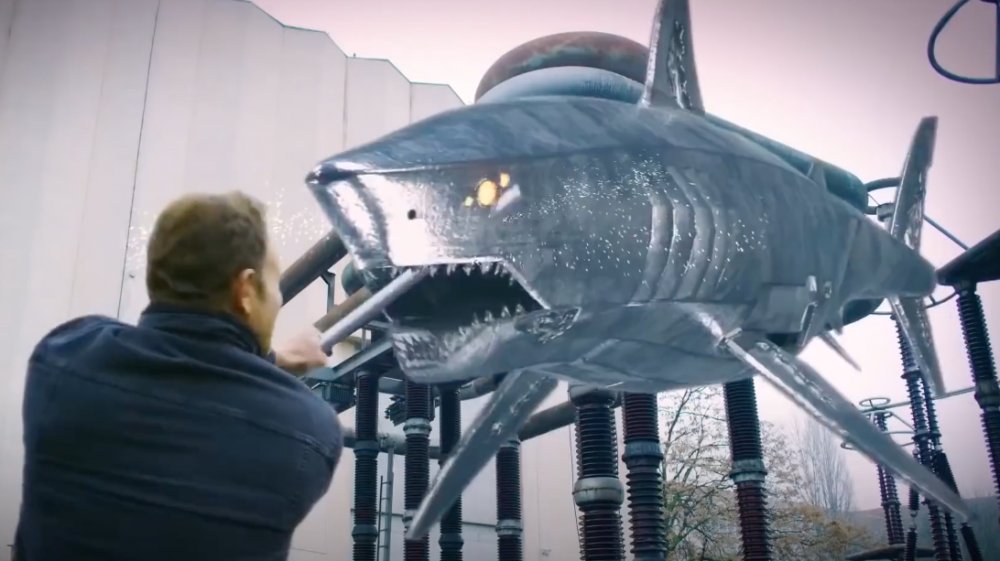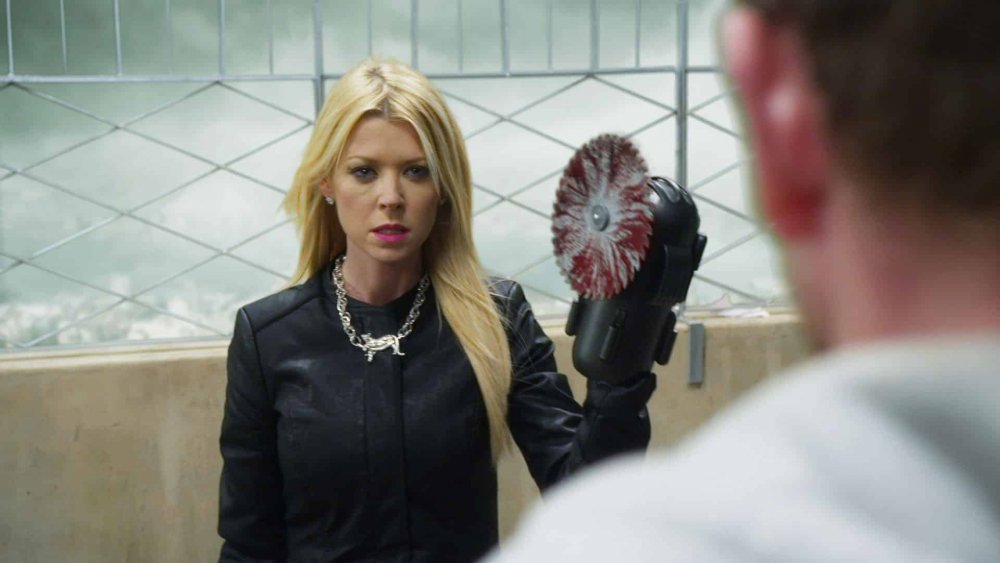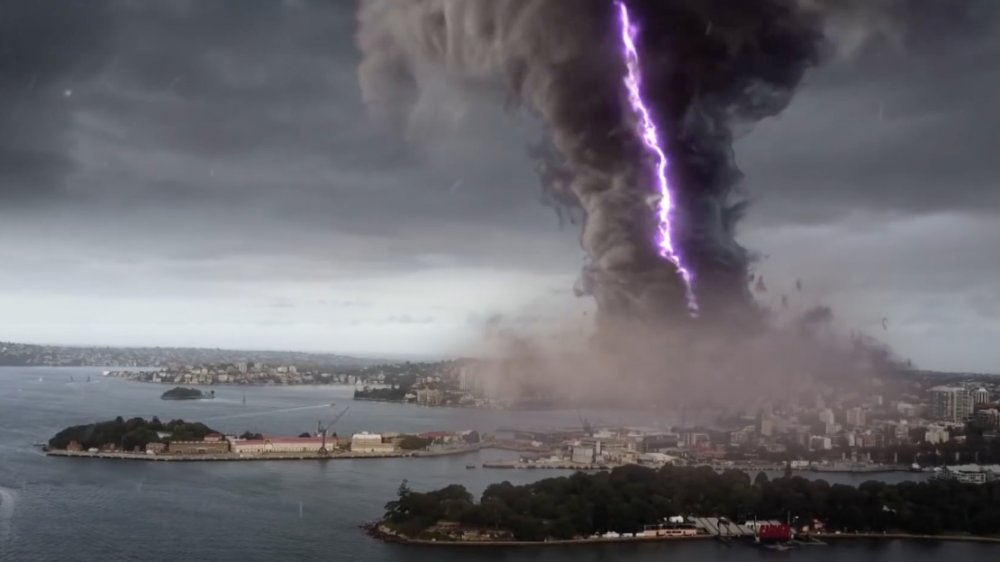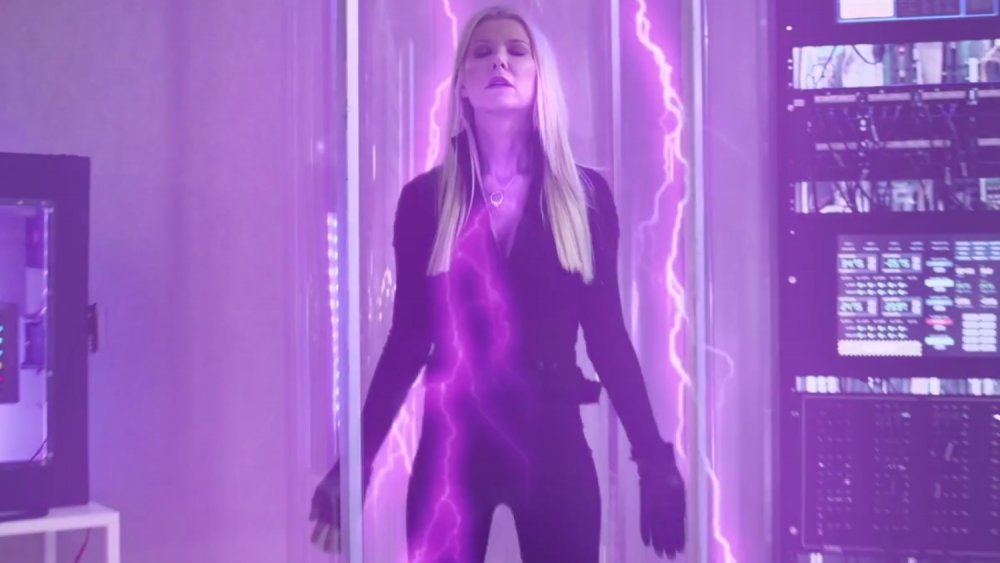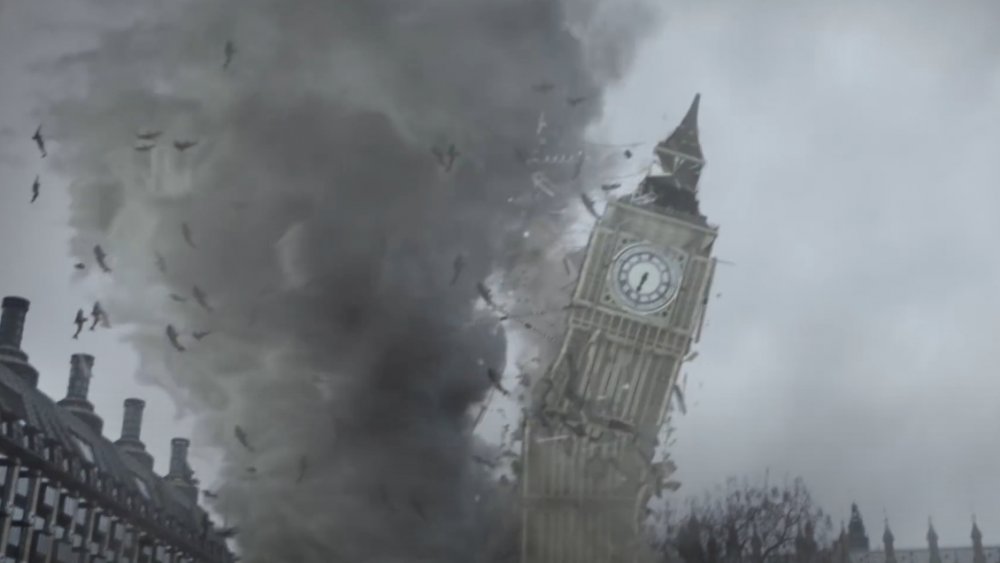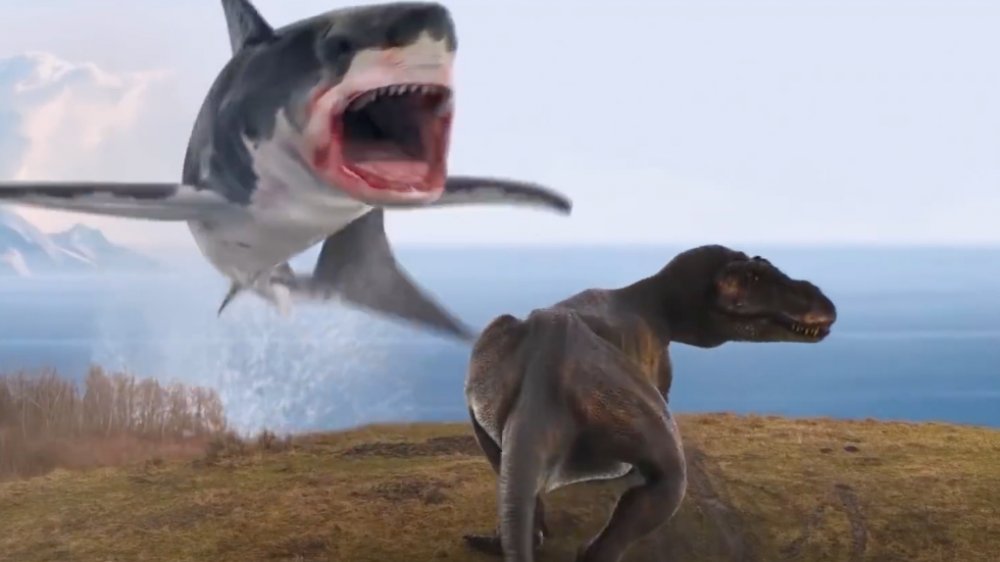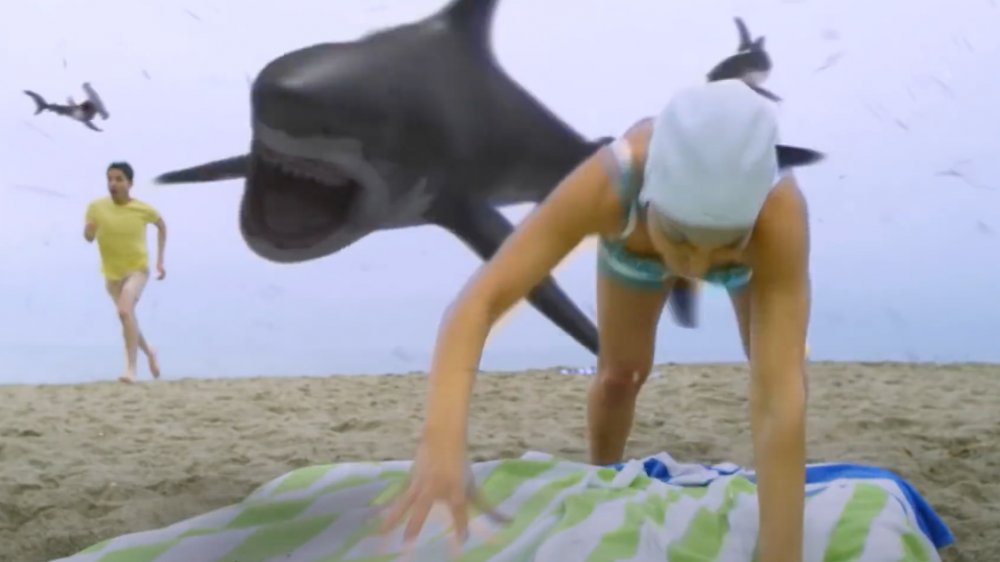The Entire Sharknado Timeline Explained
As awkward a truth as it may be, humans dig tales of the world ending. We're also unusually fond of big critters that can kill us as easily as we pop Tic Tacs, so it probably wasn't all that surprising, then, that a (really) low-budget film about a tornado filled with deadly flesh-eating sharks became an overnight success. The first Sharknado movie came out in 2013, and over the next few years, five new movies — each more ludicrous than the last — would follow in its blood-frothed wake.
Indeed, just when you think it's safe to poke your head out of your front door, Shark Week comes along, and the entire bloodcurdling story of man versus flying shark is replayed yet again in excruciatingly awesome movie marathon form. So what is this epic ode to sharp teeth and sharper chainsaws? Strap in, because all (or at least quite a bit) will soon be revealed. Here's the entire Sharknado timeline explained.
First, let's concede the obvious about Sharknado
The Sharknado saga plays out across six movies. A quick point of comparison here — there are nine live-action Star Wars movies in the so-called Skywalker Saga. It's worth dwelling on that for a moment. A story about a fish-laden meteorological phenomenon occupies over 60 percent of the storytelling space required to tell Star Wars. Weird weather gets over half the airtime of a sweeping space tale of quasi-magical swords, enraged arboreal Muppets, intergalactic slug gangsters, and the occasional awkwardly incestuous kiss to keep things spicy.
In other words, Sharknado is bloated, almost incredibly so. Even ardent fans of the movies concede that the story arc is more flabby and tangled than two well-past-their-prime alpha male walruses wrestling in a giant vat of spaghetti. Across a full 540 minutes of airborne aquatic carnage, you'll encounter very little evidence that these movies were designed around a taut and cohesive plot. For example, the physical laws governing what Jeva Lange of The Week describes as a "swirling whirlwind of teeth" constantly shift, distort, and flat-out contradict themselves. And in the earlier movies, sharks seem to be as surprised as humans that they've suddenly become airborne, toothy ballistic missiles. Later, they seem eerily deft at the whole flying thing, soaring eagle-like through the air to gracefully decapitate their next victim.
Sharknado is, quite simply, a journey into abject silliness. For many fans, the unapologetic ridiculousness is what makes this universe so wonderfully glorious. In Sharknado, the rules are more like guidelines.
Where Sharknado all began
While the story of Sharknado has many twists and turns, almost everything you need to really understand about the "why" of these movies occurs in the original 2013 film's opening scenes. In the first few minutes of the movie, the audience is deposited somewhere off the coast of Mexico — predictably enough in dark and treacherously stormy seas — where a lone fishing vessel is involved in an illegal shark fishing operation. The operation's unsurprisingly evil mastermind, one Captain Santiago, is there for an enormous pod of 20,000 sharks passing through those cursed waters. Just to seal the deal on his nasty-person vibe, Santiago shares the secret of his success as a shark fisherman and really drives home the idea that humans are, at least partly, the bad guys in this flick: "We shouldn't be afraid of the sharks. They are the ones that should be afraid of us."
A giant tornado sucks aforementioned sharks into a vicious maelstrom, and in the swirling moments of mayhem which follow, the hunters become the hunted. Santiago's face is unceremoniously removed by a ravenous shark, and voila! The sharknado phenomenon is born. Five minutes of viewing is all it takes to understand this movie's main (and, let's face it, possibly only) serious message. Don't take nature for granted — especially if it flies and has rows of teeth.
The moment Sharknado got personal
The other important plot revelation in Sharknado (2013) is that the sharknado event isn't just a faceless weather phenomenon — this story is personal. Cut to sunny waters at Santa Monica Pier, where we meet the guy who's going to make it right. Fin Shepherd is a retired champion surfer who now owns a bar. In shape without being buff, good-looking without being handsome, well-meaning without being a Boy Scout, Fin Shepherd is to Sharknado as John McLean is to the Die Hard movie franchise. He's relatable.
When the hideous sharknado bears down on Santa Monica's pleasant shores, at first Fin is as lost and confounded by the whole flying shark thing as everyone else. But then his big life-defining moment happens: His bar is destroyed. And then, mere minutes later, his barstool-wielding buddy, George, becomes the airborne shark equivalent of a pizza pocket. Here, Sharknado's hero is born. Separated from his cozy life, Fin transforms. From this moment on, Fin has an eerie prescience of how sharknados work and a profound ability to kill anything with gills.
This is the odd little twist of Sharknado. Right from the beginning, it isn't just a disaster flick. It's a revenge story about a guy whose bar got messed up and whose best friend got eaten (well, most of him, anyway). Strap in, because for the next five movies, the hero will be locked in a seemingly endless struggle with the forces of shark chaos.
V is for vendetta in Sharknado 2
Sharknado 2: The Second One was released in 2014, and it's established pretty early on that this movie will revel in delivering more of the same: nature punishing humankind for its arrogance, an ordinary good guy on a crusade to right a personal wrong, and — perhaps most importantly — a joyful cinematic buffet of melt-in-your-mouth-dumb candy. The second movie shifts the action to New York City. In NYC to promote their book on sharknado survival, Fin and April encounter not one but three sharknados, which converge over the Empire State Building. Thanks to plucky New Yorkers, an industrial-sized tank of Freon, and April's handy-dandy circular saw arm, the shark-shucking duo saves the city, the high point, arguably, being Fin majestically riding a great white shark to its inevitable doom. Then Fin proposes to April, adding a final saccharine sprinkling of romance to 95 minutes of nonstop shark guts.
While essentially the same story as the first movie, Sharknado 2 has an added ingredient X. It's never stated overtly or explained away, but it becomes clear that there are just way too many aerial elasmobranchiic incursions to consign to mere coincidence. These damnable sharks want something. Anthony C. Ferrante said in an interview with Fast Company, "Maybe the sharks just want revenge because we killed them in the first movie." Sharknados aren't just unusually fishy weather. They're a shark-frenzied vendetta.
Taking it to DC in Sharknado 3
Sharknado 3: Oh Hell No! came out in 2015, and by now, these movies had begun to attract a cult following. In the opening scenes of the third installment, there's an obvious smirk of directorial self-awareness that too stupid ain't nearly deliciously stupid enough. Fin Shepherd is in DC to receive — brace yourselves — the Presidential Medal of Freedom. Yet again, a sharknado strikes. And again, Fin makes it right, this time with the aid of the president. (A fun little aside here: According to Vanity Fair, Donald Trump was originally slated to play the role of president.)
For various movie-science reasons, the battle is taken up into space, where sharks demonstrate an odd affinity with zero-gravity conditions. Armed with a high-tech space chainsaw, Fin once again emerges victorious, re-entering Earth's atmosphere inside an enormous flaming shark's roiling innards. April gives birth during this whole space encounter, and in the final moments, it looks as though the shark-destroying heroes are heading straight for a "they lived happily ever after" movie ending, but then tragedy strikes when April is crushed beneath cascading space shuttle fragments. Oh, and adding insult to injury, the White House is destroyed. Sharknado 3 proves that these sharks are nothing if not determined to make life uncomfortable for humankind.
Fin is finally fallible in Sharknado 4
Flash forward five years after the first wave of attacks. In Sharknado: The 4th Awakens, humankind, quite understandably, is working hard to find a way to deal with its sharknado problem once and for all. The head of a suspiciously Tesla-like company, Astro-X, claims to have invented a technology that, through various science-y reasons, can destroy sharknados before they become a threat. It appears that Fin and April may finally be able to settle down to regular life. Unfortunately, in clear echoes of the human hubris that screwed everything up to begin with, the 'nado-busting technology fails spectacularly. Shockingly, after five years of detente betwixt shark and humankind, the deadly threat has returned.
Once again, Fin has cause to prove his lethal prowess with a chainsaw. Tragically, he's bitten in the chest by a shark. Then he's eaten whole by a shark. Then three additional sharks get in on the action and swallow each other in quick succession. Oh, and then a whale downs the whole shebang like it's a really complicated portobello mushroom pizza. Fin is eventually saved by his now heavily robotic wife, April (because why not?), but the viewer gets to see that Fin is fallible. Worse, unlike the previous movies, humans achieve only a hollow victory. The Eiffel Tower being ripped out of Paris and crash-landing at Niagara Falls is the sharks' none-too-subtle message that their destructive vendetta is far from over. It's also, as Deadline points out, a clear demonstration that no storyline is too improbable.
Upping the ante with the A-word in Sharknado 5
By 2017, when the fifth installment in the Sharknado epic came out, the endless, shambling lineup of C-grade zombie movies was getting older and staler by the minute. By contrast, the majestic sight of a 25-foot great white emerging from a roiling, rain-drenched sky to wreak death and vengeance on the bleating human masses still had something fresh and aesthetically pleasing about it. Sure, it was fun seeing Los Angeles, New York City, and finally the entire US East Coast brought to ruin by our worst aquatic nightmares, but why stop there? People wanted more! It was time for Sharknado to embrace its destiny. It was time for Sharknado to become an apocalypse story.
In Global Swarming, April is destroyed, and Fin suffers the hellish fate of being the last remaining human on a sharknado-decimated Earth, doomed to contemplate his complete failure until his dying breath. Or so it seems ... until Dolph Lundgren rocks up Back to the Future-style in a flying Humvee and whisks Fin away to slay another day. Redemption awaits. This movie also delivers what may well be one of the best lines in cinematic history when April declares, "I'm a lot of things, but I'm not a human helicopter." Sharknado 5: Global Swarming busted in the door of the apocalypse genre with a manic smile and a deluxe bucket of microwave popcorn. Oh, and Fabio plays the Pope. That's probably a side detail worth mentioning.
Weaponized Glory
In Sharknado 5: Global Swarming, we encounter a growing chasm between April and Fin. Ultimately, Fin is just a reasonably buff dude with a good work ethic and a chainsaw. By contrast, Fin's wife April is closer to a full-fledged superhero. There's something inhumanly flinty and determined about April Shepherd née Wexler. Case in point: when April's hand was bitten off near the beginning of the storyline, April's priority is to turn lemons into lemonade by fashioning a devastatingly effective circular saw weapon and affixing it to her arm stump. And this is just the beginning of her transformation. Over the course of her seemingly endless battles with the sharknado, April will die, be resurrected as a cyborg, and gain a slew of devastating anti-shark technologies, each more powerful than the last.
As April's Sharknado Wiki entry (yep, because that's a thing) attests, she achieves her apex weaponized glory as a disembodied head riding in the mouth of a gigantic shark. April is an enigma. Fin changes very little throughout the movies — he remains that down-to-earth and relatable surfer dude right up to the closing credits of the last film. April, on the other hand, transforms beyond recognition, in many ways becoming as destructive and horrific as the shark apocalypse she's destined to help overcome. Is April a tragically broken human hero, or a shark's most terrifying nightmare? Either way, she becomes the Gandalf to Fin's mild-mannered Frodo.
Time heals all shark-inflicted wounds
And so we hit the apocalyptic showdown in the appropriately named sixth installment, The Last Sharknado: It's About Time. In an ever-expanding tornado of improbability, the franchise had hit what seems like every major disaster trope, up to and including the world ending and Fabio as the Pope, probably in that order of heinousness. Where next? Of course, it had to be time travel. So it comes to this. Sharknado was probably always destined to end its epic tale as a misshapen unholy trinity of Jaws, Back to the Future, and Scooby-Doo.
Fin teams up with some old allies and successfully destroys the original Sharknado that would eventually bring humankind to its knees. After a romp through history, from the Wild West with Billy the Kid to encounters in medieval Camelot, Fin destroys a time-devouring timenado, saving the time-space continuum and forever diverting history away from the original timeline that had brought six movies' worth of shark-induced disaster to the planet. Why exactly Fin's actions forever removed the threat of vortex-induced cartilaginous fish massacre remains largely unexplained. But why quibble? The threat is over. Order is restored. And all it took was a spot of time travel.
Did Sharknado jump the shark?
It's hard to argue that the story had nowhere else to go, and it's probably a bit dumb to dwell on the question of whether the franchise crossed a line in getting there. This is a story about flying sharks — there never was a line to begin with. But fans still argue over the more critical question of whether the story ended well.
An AV Club reviewer described the last Sharknado movie as the "last flopping gasp of a series well past its sell-by date." In the "last flopping gasp" camp, there's the classic problem so many time travel stories encounter. You can use time travel to do anything, and this bleeds any semblance of tension right out of the story — like a freshly shark-chomped jugular. The audience experiences what the AV Club reviewer described as the lazy feeling of, "It's time travel, don't worry about it."
There's a deeper tragedy, though. By having Fin prevent the first sharknado from happening, the whole story is unwound. Fin's heroism is erased from this fictitious universe's history. It never happened. Fin never mattered. But is there a high point? Why, yes there is. Thanks to time travel, we get to see a shark eat a tyrannosaurus. If that isn't a perfect pinnacle to the Sharknado chronicles, it has to be pretty close.
What does it all mean?
So here we are. We live in a world where a flagrantly loopy story of a deadly horde of flying sharks was able to attract over two million viewers at the height of its pop culture relevance. We also live in a world where people eat Tide Pods. Setting recreational laundry detergent consumption aside, though, what's the attraction of the existentially ridiculous premise of a tornado filled with sharks?
One theory is that our monsters of choice rise up from repressed guilt. Could the sharknado be a psychosocial manifestation of our species' gradual destruction of the Earth's precious oceanic resources? Those of a more pessimistic bent might be drawn to the theory that humans have an odd fascination with the process of destruction. As one psychologist wrote in Psychology Today, "We are enamored of ruin. Our secret and ecstatic wish: Let it all fall down." Perhaps the mindless destruction of a tornado combined with the callous, predatory perfection of a shark is the best vehicle our imaginations can conjure to tear all our precious achievements to shreds, all while we watch with mouths agape, nomming happily on freshly ruptured corn kernels? Then there's star Tara Reid's simpler take on the Sharknado phenomenon: "It makes people happy. It doesn't take itself seriously."
That works.
